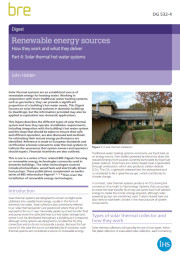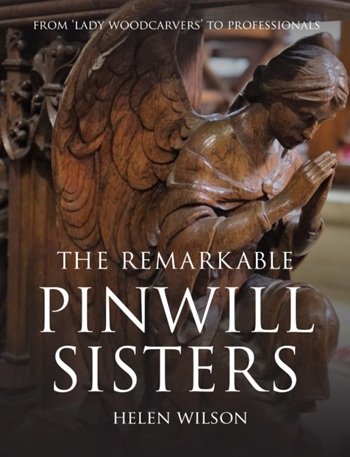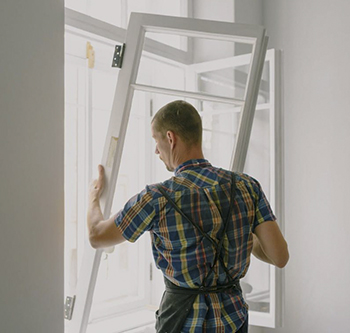Renewable energy sources: how they work and what they deliver: Part 4: Solar thermal hot water systems DG 532 4
BRE (Building Research Establishment) is an independent, research-based consultancy, testing and training organisation, operating in the built environment and associated industries.
Renewable energy sources: how they work and what they deliver: Part 4: Solar thermal hot water systems (DG 532/4) was written by John Holden and published by BRE on 5 December 2014.
This is one in a series of four BRE Digests focusing on renewable energy technologies commonly used in domestic buildings. They complement an earlier series of BRE Information Papers that cover the installation of renewable energy technologies.
The other technologies covered include:
- Photovoltaics.
- Wood fuels.
- Electrically-driven heat pumps.
Solar thermal systems are designed to convert sunlight (solar radiation) into useable heat energy, usually in the form of domestic hot water. Solar collectors (also commonly referred to as solar thermal panels) are positioned where they will be exposed to the sun’s rays. Generally speaking, a heat transfer fluid and pump move the collected heat to a hot water storage tank, where it can be distributed throughout a building as required, although some systems are designed to circulate the fluid by convection and so do not incorporate a pump. Working together with more traditional water heating systems, such as gas boilers, this can provide a significant proportion of a building’s hot water needs.
DG 532/4 focuses on solar thermal systems in dwellings. The information provided may also be applied to equivalent non-domestic applications. It describes:
- Different types of solar thermal system and how they operate.
- Installation requirements, including integration with hot water systems.
- The steps that should be taken to ensure safe and efficient operation.
- Methods for estimating annual energy performance.
Reference is made to European Standards and certification schemes to indicate the assurances that system owners and operators should expect. Financial incentives are also outlined.
Its contents include:
- Introduction.
- Types of solar thermal collector and how they work.
- Maintenance.
- System design considerations.
- Standards and certification.
- Conclusion.
- References.
[edit] Find out more.
[edit] Related articles on Designing Buildings Wiki
- BRE articles on Designing Buildings Wiki.
- BRE Buzz articles on Designing Buildings Wiki.
- BRE Buzz.
- BRE National Solar Centre.
- BREEAM.
- Large scale solar thermal energy.
- Heat pump.
- Odeillo solar furnace.
- Photovoltaics.
- Renewable energy sources: how they work and what they deliver: Part 3: Electrically driven heat pumps DG 532 3.
- Renewable energy.
- Solar photovoltaics.
- Solar thermal systems
- Solar-assisted heat pump.
- Wind loads on roof-mounted photovoltaic and solar thermal systems DG 489.
Featured articles and news
Skills England publishes Sector skills needs assessments
Priority areas relating to the built environment highlighted and described in brief.
BSRIA HVAC Market Watch - May 2025 Edition
Heat Pump Market Outlook: Policy, Performance & Refrigerant Trends for 2025–2028.
Committing to EDI in construction with CIOB
Built Environment professional bodies deepen commitment to EDI with two new signatories: CIAT and CICES.
Government Grenfell progress report at a glance
Line by line recomendation overview, with links to more details.
An engaging and lively review of his professional life.
Sustainable heating for listed buildings
A problem that needs to be approached intelligently.
50th Golden anniversary ECA Edmundson apprentice award
Deadline for entries has been extended to Friday 27 June, so don't miss out!
CIAT at the London Festival of Architecture
Designing for Everyone: Breaking Barriers in Inclusive Architecture.
Mixed reactions to apprenticeship and skills reform 2025
A 'welcome shift' for some and a 'backwards step' for others.
Licensing construction in the UK
As the latest report and proposal to licence builders reaches Parliament.
Building Safety Alliance golden thread guidance
Extensive excel checklist of information with guidance document freely accessible.
Fair Payment Code and other payment initiatives
For fair and late payments, need to work together to add value.
Pre-planning delivery programmes and delay penalties
Proposed for housebuilders in government reform: Speeding Up Build Out.
High street health: converting a building for healthcare uses
The benefits of health centres acting as new anchor sites in the high street.
The Remarkable Pinwill Sisters: from ‘lady woodcarvers’ to professionals. Book review.
Skills gap and investment returns on apprenticeships
ECA welcomes new reports from JTL Training and The Electrotechnical Skills Partnership.
Committee report criticises UK retrofit schemes
CIOB responds to UK’s Energy Security and Net Zero Committee report.

























